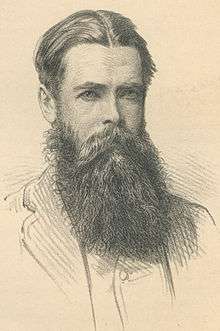George Stoddart Whitmore

Sir George Stoddart Whitmore KCMG (30 May 1829 – 16 March 1903)[1] was a notable New Zealand soldier, military leader, runholder and politician.
Whitmore was born in Malta in 1829,[1] the son of the late Major George St. V. Whitmore, R.E., and Isabella his wife, daughter of Sir J. Stoddart, Chief Justice of Malta. His grandfather, the late General Sir George Whitmore, K.C.H., was colonel-commandant Royal Engineers. G. S. Whitmore was educated at Edinburgh Academy and at the Staff College.[2]
Whitmore entered the army in 1847 as ensign in the Cape Mounted Rifles, and became lieutenant in May 1850, captain in July 1854, and brevet-major in June 1856. He served with distinction in the Kaffir wars of 1847 and 1851-3, in the Boer insurrection of 1848, and in the East with the Turkish contingent in 1855-6. He has the fourth class of the Medjidie and three medals. After exceptional services in the Crimea he went to New Zealand as military secretary to Sir Duncan Cameron in 1861.[2]
Resigning his position in the army in December 1862, Whitmore became a settler in the Hawke's Bay region. He was appointed to command the Hawke's Bay Militia in 1866, when he successfully led two hundred militia and volunteers at Omaranui, surrounded the gathering Hau Haus, who threatened destruction to the. settlement of Napier, and cut off or captured them almost to a man. In 1868 he conducted a campaign against the celebrated Te Kooti, who had just escaped from the Chatham Islands, and drove him and his followers into hiding. A month later he was placed in command of the West Coast force, which had met with some reverses, and had to be recruited and reorganised. For some considerable time Te Kooti kept the country in a state of alarm. His successes brought many wild spirits to his standard, and he placed his fortress at Ngatapa, a wooded mountain whose summit is about two thousand five hundred feet above the level of the sea. It was said to be the strongest fortified post in the North Island.[2] The massacre at Poverty Bay compelled the Government to send Colonel Whitmore to reduce this stronghold. After a siege of five days the place was taken on 3 January 1869, and the enemy escaped with very severe loss. Returning to the West Coast, he led the colonial troops successfully from Kai Iwi to the Waitara, recovering all the country that had been abandoned and defeating Titokowaru's band in several engagements. Having completely pacified the West Coast, he was sent to put down the insurrection in the Urewera mountains, where Te Kooti had once more raised a body of followers. This duty had been scarcely accomplished when a change in the Ministry occurred. Mr. Fox defeated Mr. Stafford, and at once removed Colonel Whitmore from the command of the troops in the field, just at the moment when complete success appeared close at hand. Te Kooti, being unpursued, was able to recover from the effects of defeat; and it was consequently eighteen months afterwards before he was again reduced to the same straits. In October 1877 Colonel Whitmore joined Sir George Grey's Ministry as Colonial Secretary and Defence Minister, retiring in October 1879, with the rest of his colleagues. In 1870 he was appointed C.M.G., and in the 1882 Birthday Honours K.C.M.G.[2]

Whitmore was appointed to the New Zealand Legislative Council on 31 August 1863 and served until his death almost 40 years later.[3] Sir George was a member of the short-lived Stout-Vogel Cabinet in August 1884, as a Minister without portfolio.[2] The same combination coming back to power in September of the same year, he was appointed commandant of the colonial forces and commissioner of the armed constabulary, with the rank of major-general, conferred for the first time in New Zealand on an officer of the colonial forces. Sir George married in 1865 Isabella, daughter of the late William Smith, of Roxeth, near Rugby, England.[2]
On 16 March 1903 Whitmore died in Napier, New Zealand.[1]
References
- 1 2 3 Belich, James. "George Stoddart Whitmore". Dictionary of New Zealand Biography. Ministry for Culture and Heritage. Retrieved October 2013. Check date values in:
|access-date=(help) - 1 2 3 4 5 6 Mennell, Philip (1892). "
 Whitmore, Major-General the Hon. Sir George Stoddart". The Dictionary of Australasian Biography. London: Hutchinson & Co. Wikisource
Whitmore, Major-General the Hon. Sir George Stoddart". The Dictionary of Australasian Biography. London: Hutchinson & Co. Wikisource - ↑ Scholefield, Guy (1950) [First ed. published 1913]. New Zealand Parliamentary Record, 1840–1949 (3rd ed.). Wellington: Govt. Printer. p. 87.